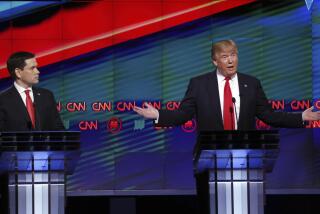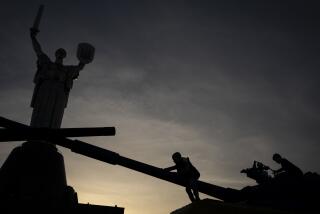NEWS ANALYSIS : Gorbachev Grows Hesitant at Economic Turning Point : Soviet Union: He is caught in middle between radicals urging total overhaul and go-slow advocates.
- Share via
MOSCOW — Soviet President Mikhail S. Gorbachev, faced with a crucial test that will determine whether perestroika succeeds or fails, is showing surprising hesitation on the decisive issue of economic reform.
The point has come, Gorbachev told Soviet lawmakers this week, when the country must choose a new economic system to replace the rapidly failing state socialism with which the Communist Party has governed for seven decades.
But Gorbachev, so decisive in the past, now appears to be uncertain, almost as if he were paralyzed by the fatefulness of the choice on his perestroika (restructuring) program.
Radicals are advocating the complete abandonment of the present system in favor of a market economy. Those charged with managing this transition call for a gradual, more cautious change, fearing the upheaval it could bring. Few still believe that simple reforms can pull the Soviet Union out of its most profound economic crisis.
The differences among the reformers are great, however, and the debate is furious, for a unique, historic moment of decision has come.
“This is the time for decisions,” Gorbachev told the Supreme Soviet, the national legislature, but clearly he has not resolved his own position on some of the most fundamental issues involved.
His hesitation is putting his leadership in question. He is wavering between the radical course that he said again this week he believes to be correct and the concern he shares with government officials over the chaos that could result if mistakes are made.
As the Supreme Soviet has debated the reform proposals this week, Gorbachev has seemed to weigh the dangers of making a fatal mistake against the need for rapid change. His ambivalence has thrown most of the deputies and the nation into uncertainty.
In a speech of caution and doubt, he called for a national referendum on a key radical proposal, the private ownership of land, although it would delay and possibly wreck the reform program he favors.
Others, notably the populist Boris N. Yeltsin, president of the Russian Federation, are pushing ahead with the radical program, and Soviet political commentators are openly asking whether events have now overtaken “the initiator of perestroika .”
“Gorbachev is at the brink, the point where he must leave behind all that he has known for his 60 years, and he is not certain whether he can do it,” a prominent political scientist said after sitting with the president and his advisers last week as they weighed the various options.
“A wrong choice would not only end his leadership and most, if not all, that he has tried to do, but it could doom the Soviet Union, simply doom it. Famine, civil war, the country’s breakup, total chaos--all are possible if we err now.”
The crux of the problem lies in the fundamental nature of the choice that the Soviet Union must make on what type of socioeconomic system it will have in the 21st Century and how it will develop it.
This is what perestroika has been about over the last five years. It has embraced the political reforms that brought the nation from silent obedience to democracy, the Communist Party’s retreat from a 70-year monopoly on power, and the incessant questioning of the goals and values the country has held since the Soviet state was founded--and of the 1917 Bolshevik Revolution itself.
All that was prologue to the change that the Soviet Union’s 285 million people must now make. It freed them from the ideological constraints imposed by so many decades of socialism and began the demolition of the system that the world had come to understand as “Soviet” and, indeed, socialist.
But a decision must now be made on what system will replace it, and the choice is far from simple. There are political, social and strategic as well as economic considerations, and the growing turmoil throughout the country means the choice must be made quickly.
Again this week, Gorbachev endorsed in principle the most radical of the proposals under consideration--a 500-day timetable for the reconstruction of the Soviet economy by replacing state ownership, bureaucratic management and central planning with private property, entrepreneurship and market forces.
Named for its principal author, Stanislav S. Shatalin, one of Gorbachev’s closest advisers, the program starts with the wholesale privatization of state enterprises, sweeping land reform to dissolve state and collective farms, and the formation of a stock exchange and capital market and price reform.
The program also calls for austerity measures, including severe cuts in all government spending, particularly for defense and foreign aid, in order to balance the budget by the end of this year. The Soviet currency, the ruble, will be devalued until it is freely convertible into dollars or other Western currencies.
The goal is to establish, within 18 months, a market economy in which, as one of the other authors said, there “will be an abundance of goods, (and) shop shelves will be full of inexpensive commodities.”
In a nation that cannot feed, clothe or house its people, where once-plentiful staples such as bread have disappeared from stores even when rationed, this would be such an economic miracle that the interim period of austerity would be accepted with few questions or complaints.
One of the most attractive features of the Shatalin program is the envisioned speed with which the Soviet economy would be turned around. While government economists talk of 10 years and speak mostly in the subjunctive about what might be, Shatalin promises initial results after the first 100 days, more after 200 and still more after 300 and 400 until the country is on the road to prosperity.
Yet, Gorbachev is troubled by a number of aspects of the Shatalin program, as are many deputies in the Supreme Soviet and economists who are appraising it in anticipation of a decision this month.
Of greatest concern is whether the “safety net” that Shatalin has designed will really protect workers and farmers from the full impact of rising prices and mass unemployment.
The prospect of sharp increases, including the tripling of the long-subsidized price of bread, led to a wave of panic buying last spring that could easily have turned into riots. Although the plan freezes the prices of up to 150 “essential goods” until the program’s final stage, some economists now estimate that inflation could reach 40% a month or more, and wages will not rise as fast.
A quarter of the country’s collective and state farms could go bankrupt, a fifth of the coal mines might have to be closed and, nationwide, unemployment would probably rise immediately to 10 million and eventually 30 million. Strikes by coal miners, steel workers and railway workers over the last year have already deepened the economic crisis.
Gorbachev, who earlier pledged that his economic reforms would hurt no one, has been chastened by a severe decline in living standards in the last two years.
Doubts are also growing over whether the market can develop quickly enough after the curtailment of central planning to halt the economic chaos--and not accelerate it as Gorbachev’s initial economic reforms did.
Since the beginning of the year, industrial production has declined an estimated 2%, unemployment stands at 8 million, the trade deficit is six times what it was in January and the budget deficit has soared to the equivalent of $280 billion at official exchange rates.
Inflation is put at 8% by government statisticians and nearly three times that by independent economists, and, outside of the major cities, 70% to 90% of all consumer goods are reported to be in such short supply that they are officially described as unavailable.
Prime Minister Nikolai I. Ryzhkov, who has put forward the government’s program for a more gradual transition to a market economy, has warned that the radicals’ proposals will bring collapse.
“Shock therapy, the sheer chaos and severity of it, will kill us,” Ryzhkov said, adding that he would quit rather than administer such a program.
Shatalin and other radical economists assured deputies this week that the market itself will be the great economic integrator, with the forces of supply and demand bringing together consumers and producers where the state has failed.
“What we are dealing with is a mind-bogglingly complicated system,” said Grigori A. Yavlinsky, a vice premier of the Russian Federation, who helped draft the 500-day plan. “So many factors have an impact that to promise people some specific gains after so many days would be tantamount to cheating them again. Our blueprint is about a locomotive to pull the economy towards a market system, not about per-capita production of eggs.
“I do not know of any other way of switching the economy over to a market system--or, to put it differently, to a normal life--that would let us avoid a social upheaval, safeguard the continuity of our traditions and not disrupt the links between the past and the future.”
The final worrying factor for Gorbachev is the break with socialism. When deputies openly said that the “path to the market,” as the reforms have been described, is “the road to capitalism,” it clearly rankled.
Where he had spoken of a “market economy,” Gorbachev began to refer to a “mixed economy,” with the state still predominant through its policy-making and regulatory agencies and through ownership of many large enterprises.
The Soviet market would be a socialist market, with the state still in control, Gorbachev said. Private property, in effect private enterprise, was necessary, but it would never be the motor of the Soviet economy.
What troubled Gorbachev most, however, was the radicals’ proposal for private ownership of land, which was nationalized by the Communist Party in the collectivization of agriculture. The reform would lead to the breakup of many state and collective farms and introduce the question of mineral and other rights in the exploitation of natural resources.
“A heated and bitter debate is going on concerning the private ownership of land,” the president said. “This is one of the fundamental issues, and it seems to me that it must be resolved in a referendum. This is too serious a problem to be decided in offices, auditoriums or conference halls. . . . It is the sovereign right of the people to decide, and it can only be done in a referendum. This is my firm opinion.”
The referendum would be unprecedented in Soviet history, Shatalin pointed out later, and would delay implementation of the program at least six months. Whatever the formal issue, the debate would exclude no aspect of the reforms, and the result could undermine the whole reform package.
But Soviet analysts, attempting to see the present situation from Gorbachev’s perspective, believe that he may view the referendum--or perhaps just the threat of one--as establishing a popular mandate for the most difficult issues in the radicals’ program.
“With a referendum victory, no one would again question the most radical measures he undertook,” a senior Soviet political commentator remarked. “If the conservatives--and they are still a significant force--back down out of fear of such a ballot, that is almost as good. . . .
“Still, there is the possibility of a loss, and then it would be over for the radicals and probably for Gorbachev, too.”
More to Read
Sign up for Essential California
The most important California stories and recommendations in your inbox every morning.
You may occasionally receive promotional content from the Los Angeles Times.












